display RENAULT KANGOO 2012 X61 / 2.G User Guide
[x] Cancel search | Manufacturer: RENAULT, Model Year: 2012, Model line: KANGOO, Model: RENAULT KANGOO 2012 X61 / 2.GPages: 237, PDF Size: 8.62 MB
Page 67 of 237
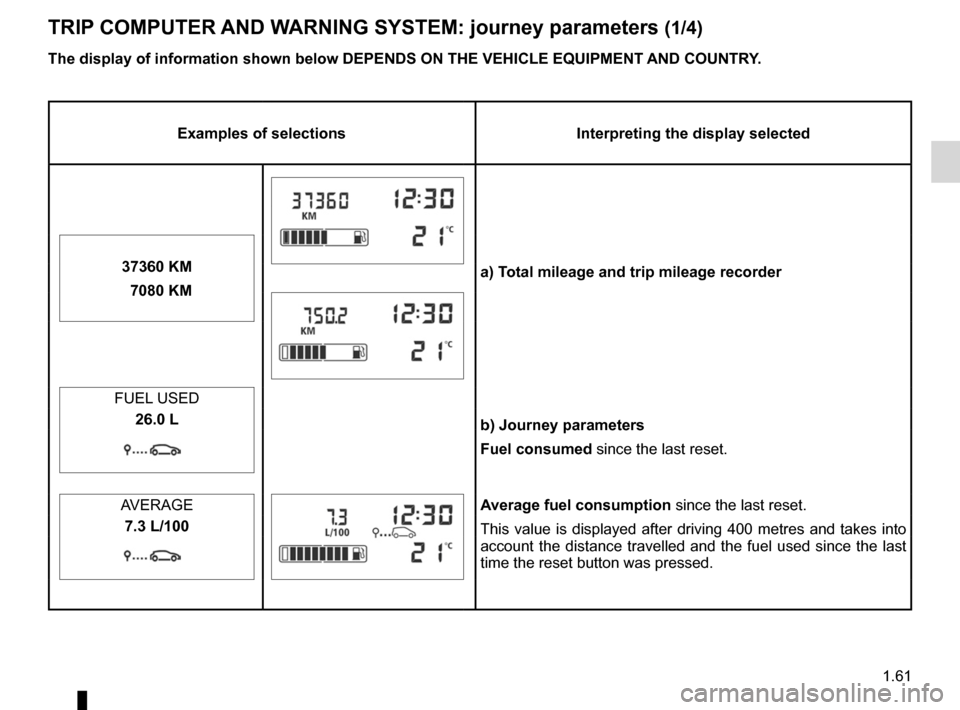
trip computer and warning system........(up to the end of the DU)
warning lights ........................................ (up to the end of the DU)
instrument panel messages ..................(up to the end of the DU)
instrument panel ................................... (up to the end of the DU)
1.61
ENG_UD26556_3
Ordinateur de bord : paramètres de voyage (X85 - X61 - F61 - K61 - Renault)
ENG_NU_813-11_FK61_Renault_1
TRIp COMpUTeR AND WARNING SySTeM: journey parameters (1/4)
examples of selectionsInterpreting the display selected
a) Total mileage and trip mileage recorder
37360 KM
7080 KM
b) Journey parameters
Fuel consumed since the last reset.
FUEL USED
26.0 L
AVERAGEAverage fuel consumption since the last reset.
This value is displayed after driving 400 metres and takes into
account the distance travelled and the fuel used since the last
time the reset button was pressed.
7.3 L/100
The display of information shown below DepeNDS ON THe veHICLe eQUIpMeNT AND COUNTR
y.
Page 68 of 237

1.62
ENG_UD26556_3
Ordinateur de bord : paramètres de voyage (X85 - X61 - F61 - K61 - Renault)
ENG_NU_813-11_FK61_Renault_1
Jaune NoirNoir texte
TRIp COMpUTeR AND WARNING SySTeM: journey parameters (2/4)
examples of selectionsInterpreting the display selected
CURRENT
Current fuel consumption
This value is displayed after a speed of approximately 20 mph
(30 km/h) is reached.
8.6 L/100
RANGEestimated range with remaining fuel
This range takes into account the average fuel consumption
since the last time the reset button was pressed.
The value is displayed after driving 400 metres.
Several minutes after the reserve light has come on (refer to the
information on the “Instrument panel”), the estimated range will
no longer be displayed.
402.0 KM
DISTANCE
Distance travelled since the last reset.
430.0 KM
AVERAGE
Average speed since the last reset.
The value is displayed after driving 400 metres.
109.2 KM/H
The display of information shown below DepeNDS ON THe veHICLe eQUIpMeNT AND COUNTR
y.
Page 69 of 237
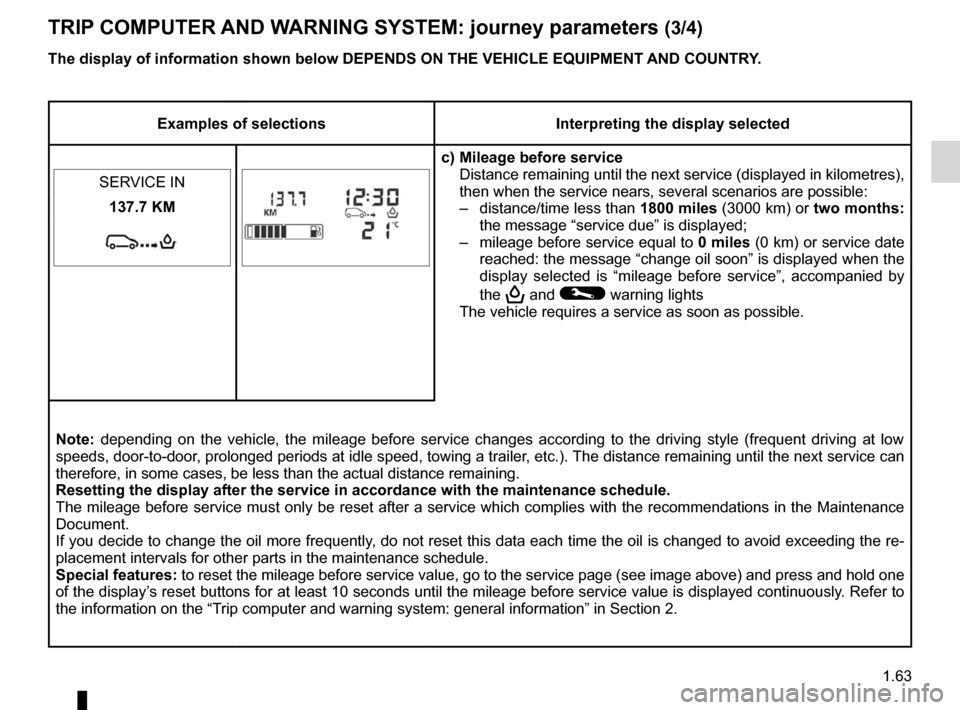
JauneNoirNoir texte
1.63
ENG_UD26556_3
Ordinateur de bord : paramètres de voyage (X85 - X61 - F61 - K61 - Renault)
ENG_NU_813-11_FK61_Renault_1
TRIp COMpUTeR AND WARNING SySTeM: journey parameters (3/4)
examples of selectionsInterpreting the display selected
c) Mileage before service
Distance remaining until the next service (displayed in kilometres),
then when the service nears, several scenarios are possible:
– distance/time less than 1800 miles (3000 km) or two months:
the message “service due” is displayed;
– mileage before service equal to 0 miles (0 km) or service date
reached: the message “change oil soon” is displayed when the
display selected is “mileage before service”, accompanied by
the
9 and © warning lights
The vehicle requires a service as soon as possible.
SERVICE IN
137.7 KM
Note:
depending on the vehicle, the mileage before service changes according to the driving style (frequent driving at low
speeds, door-to-door, prolonged periods at idle speed, towing a trailer, etc.). The distance remaining until the next service can
therefore, in some cases, be less than the actual distance remaining.
Resetting the display after the service in accordance with the maintenance schedule.
The mileage before service must only be reset after a service which complies with the recommendations in the Maintenance
Document.
If you decide to change the oil more frequently, do not reset this data each time the oil is changed to avoid exceeding the re-
placement intervals for other parts in the maintenance schedule.
Special features: to reset the mileage before service value, go to the service page (see image above) and press and hold one
of the display’s reset buttons for at least 10 seconds until the mileage before service value is displayed continuously. Refer to
the information on the “Trip computer and warning system: general information” in Section 2.
The display of information shown below DepeNDS ON THe veHICLe eQUIpMeNT AND COUNTR
y.
Page 70 of 237
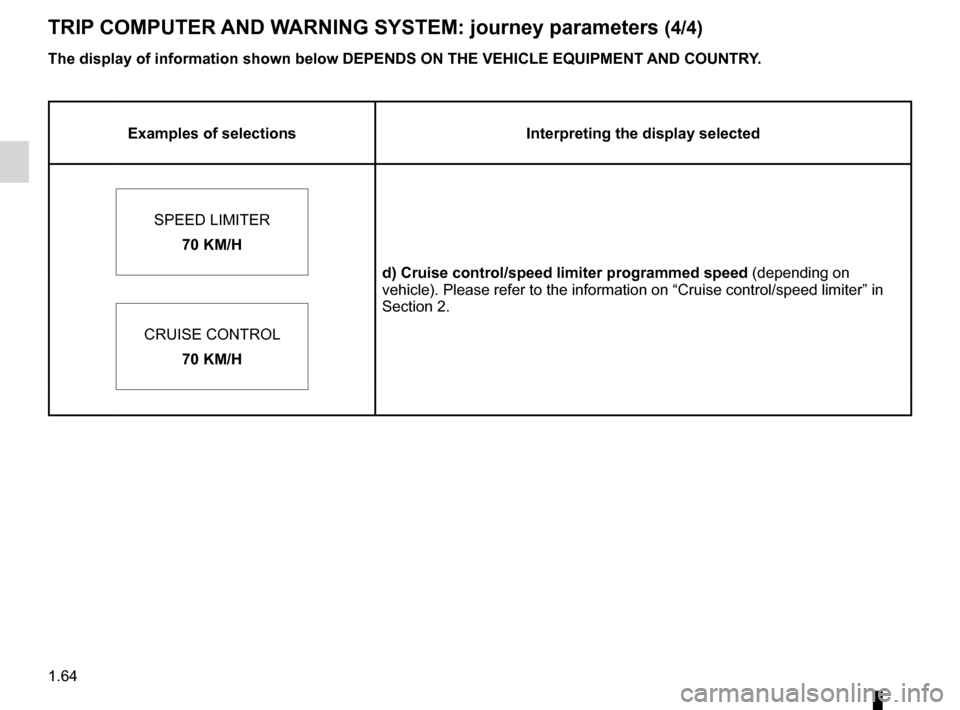
1.64
ENG_UD26556_3
Ordinateur de bord : paramètres de voyage (X85 - X61 - F61 - K61 - Renault)
ENG_NU_813-11_FK61_Renault_1
examples of selections Interpreting the display selected
SPEED LIMITER d) Cruise control/speed limiter programmed speed (depending on
vehicle). Please refer to the information on “Cruise control/speed limiter” in
Section 2.
70 KM/H
CRUISE CONTROL 70 KM/H
TRIp COMpUTeR AND WARNING SySTeM: journey parameters (4/4)
The display of information shown below DepeNDS ON THe veHICLe eQUIpMeNT AND COUNTR y.
Page 71 of 237
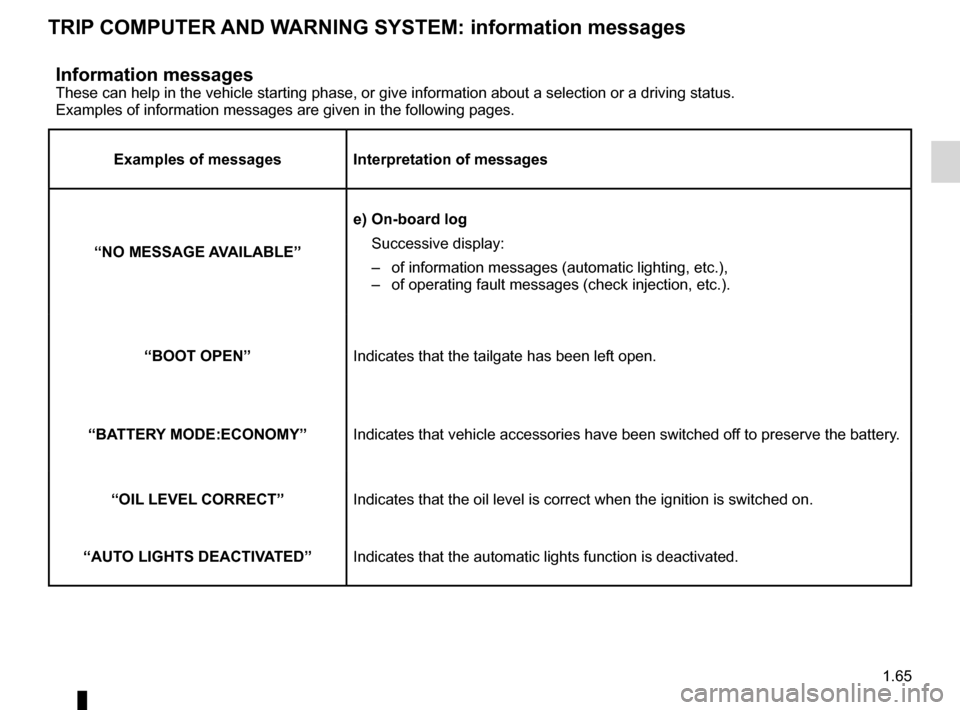
trip computer and warning system........(up to the end of the DU)
warning lights ........................................ (up to the end of the DU)
instrument panel messages ..................(up to the end of the DU)
instrument panel ................................... (up to the end of the DU)
1.65
ENG_UD23313_2
Ordinateur de bord : messages d’information (X61 - F61 - K61 - Renault)
ENG_NU_813-11_FK61_Renault_1
Information messagesThese can help in the vehicle starting phase, or give information about a selection or a driving status.
Examples of information messages are given in the following pages.
examples of messages Interpretation of messages
“NO MeSSAGe A vAILABLe” e)
On-board log
Successive display:
– of information messages (automatic lighting, etc.),
– of operating fault messages (check injection, etc.).
“BOOT OpeN ” Indicates that the tailgate has been left open.
“BATTeR y MODe:eCONOMy” Indicates that vehicle accessories have been switched off to preserve the battery.
“OIL LeveL CORReCT” Indicates that the oil level is correct when the ignition is switched on.
“AUTO LIGHTS DeACTIv ATeD”Indicates that the automatic lights function is deactivated.
TRIp COMpUTeR AND WARNING SySTeM: information messages
Page 72 of 237
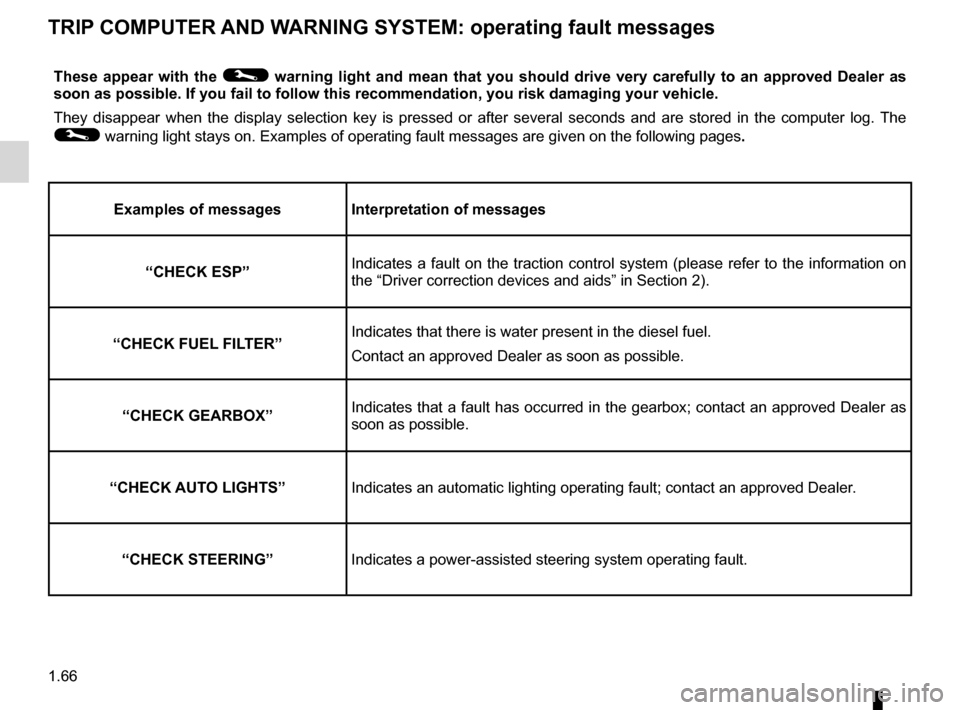
trip computer and warning system.........................(current page)
instrument panel messages ...................................(current page)
warning lights ......................................................... (current page)
instrument panel .................................................... (current page)
1.66
ENG_UD26591_3
Ordinateur de bord : messages d’anomalies de fonctionnement (X85 - X61 - F61 - K61 - Renault)
ENG_NU_813-11_FK61_Renault_1
These appear with the © warning light and mean that you should drive very carefully to an approved Dealer as
soon as possible. If you fail to follow this recommendation, you risk damaging your vehicle.
They disappear when the display selection key is pressed or after several seconds and are stored in the computer log. The
© warning light stays on. Examples of operating fault messages are given on the following pages .
examples of messages Interpretation of messages
“CHeCK eSp” Indicates a fault on the traction control system (please refer to the information on
the “Driver correction devices and aids” in Section 2).
“CHeCK FUeL FILTeR” Indicates that there is water present in the diesel fuel.
Contact an approved Dealer as soon as possible.
“CHeCK GeARBOX ”Indicates that a fault has occurred in the gearbox; contact an approved Dealer as
soon as possible.
“CHeCK AUTO LIGHTS ”Indicates an automatic lighting operating fault; contact an approved Dealer .
“CHeCK STeeRING” Indicates a power-assisted steering system operating fault.
TRIp COMpUTeR AND WARNING SySTeM: operating fault messages
Page 73 of 237
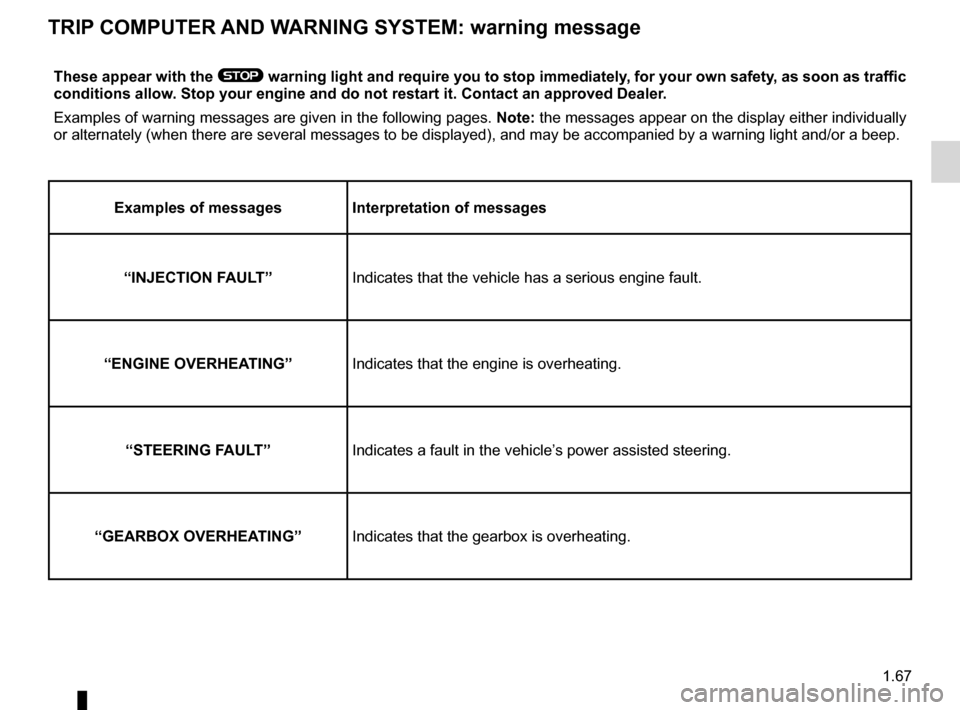
trip computer and warning system.........................(current page)
warning lights ......................................................... (current page)
instrument panel messages ...................................(current page)
instrument panel .................................................... (current page)
1.67
ENG_UD23315_2
Ordinateur de bord : messages d’alerte (X61 - F61 - K61 - Renault)
ENG_NU_813-11_FK61_Renault_1
These appear with the ® warning light and require you to stop immediately, for your own safety, as soon as traffic
conditions allow. Stop your engine and do not restart it. Contact an approved Dealer.
Examples of warning messages are given in the following pages. Note: the messages appear on the display either individually
or alternately (when there are several messages to be displayed), and may be accompanied by a warning light and/or a beep.
examples of messages Interpretation of messages
“INJeCTION FAULT” Indicates that the vehicle has a serious engine fault.
“eNGINe OveRHeATING” Indicates that the engine is overheating.
“STeeRING FAULT” Indicates a fault in the vehicle’s power assisted steering.
“GeARBOX OveRHeATING” Indicates that the gearbox is overheating.
TRIp COMpUTeR AND WARNING SySTeM: warning message
Page 74 of 237
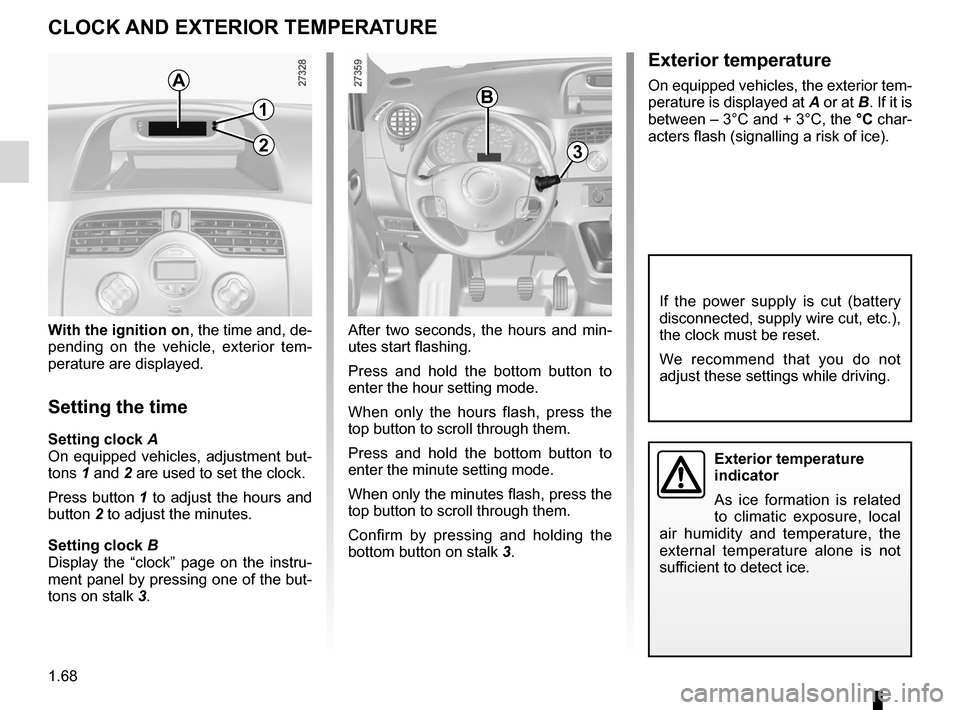
clock ..................................................... (up to the end of the DU)
clock ..................................................... (up to the end of the DU)
external temperature ............................ (up to the end of the DU)
1.68
ENG_UD21413_3
Heure et température extérieure (X61 - F61 - K61 - Renault)
ENG_NU_813-11_FK61_Renault_1
exterior temperature
On equipped vehicles, the exterior tem-
perature is displayed at A or at B. If it is
between – 3°C and + 3°C, the °C char-
acters flash (signalling a risk of ice).
Clock and exterior temperature
CLOCK AND eXTeRIOR TeMpeRATURe
exterior temperature
indicator
As ice formation is related
to climatic exposure, local
air humidity and temperature, the
external temperature alone is not
sufficient to detect ice.
A
1
2
B
3
After two seconds, the hours and min-
utes start flashing.
Press and hold the bottom button to
enter the hour setting mode.
When only the hours flash, press the
top button to scroll through them.
Press and hold the bottom button to
enter the minute setting mode.
When only the minutes flash, press the
top button to scroll through them.
Confirm by pressing and holding the
bottom button on stalk 3.
With the ignition on, the time and, de-
pending on the vehicle, exterior tem
-
perature are displayed.
Setting the time
Setting clock A
On equipped vehicles, adjustment but-
tons 1 and 2 are used to set the clock.
Press button 1 to adjust the hours and
button 2 to adjust the minutes.
Setting clock B
Display the “clock” page on the instru-
ment panel by pressing one of the but-
tons on stalk 3.
If the power supply is cut (battery
disconnected, supply wire cut, etc.),
the clock must be reset.
We recommend that you do not
adjust these settings while driving.
Page 90 of 237

stopping the engine .............................. (up to the end of the DU)
starting the engine ................................ (up to the end of the DU)
2.4
ENG_UD29639_2
Fonction Stop and Start (X61 - F61 - K61 - Renault)
ENG_NU_813-11_FK61_Renault_2
Jaune NoirNoir texte
Stop and start function
STOP AND START function (1/3)
Warning light is displayed on the
instrument panel. This notifies you that
the engine is on standby.
The vehicle equipment remain opera -
tional while the engine is stopped.
The engine will restart when you press
the clutch pedal and move into gear.
This system enables a reduced fuel
consumption and lower greenhouse
gas emissions.
The system is activated automatically
when the vehicle is started.
While driving, the system stops the
engine (standby) when the vehicle is
at a standstill (traffic jam, traffic lights,
etc).
System operating conditionsEngine standby is activated if:
– the vehicle has been driven since its
last stop;
– the gearbox is in neutral;
– the clutch pedal is released;
and
– the vehicle is travelling at less than 3
km/h. Special feature of the automatic
engine re-start
Under certain conditions, the engine
can restart on its own in order to guar-
antee your safety and comfort.
This can occur especially when:
–
the outdoor temperature is too low or
too high (less than around 0 °C or
higher than around 30 °C);
– the “Clear View” function is acti -
vated if fitted on the vehicle (please
see “Automatic Climate Control” in
Section 3);
– the battery is not sufficiently charged;
– the vehicle speed is above 7 km/h
(downhill slope, etc.);
– repeated pressing on the brake
pedal or braking system require -
ment;
– ...
Engine on standby - braking
assistance is no longer op-
erational.
Do not drive off when the
engine is on standby (warn-
ing light
is displayed
on the instrument panel).
Before getting out of the
vehicle, you must switch
off the ignition (please see
section on “Starting, stop -
ping the engine”).
If you get out of the vehicle, a beep
notifies you that the engine is on
standby and has not been switched
off.
Page 103 of 237
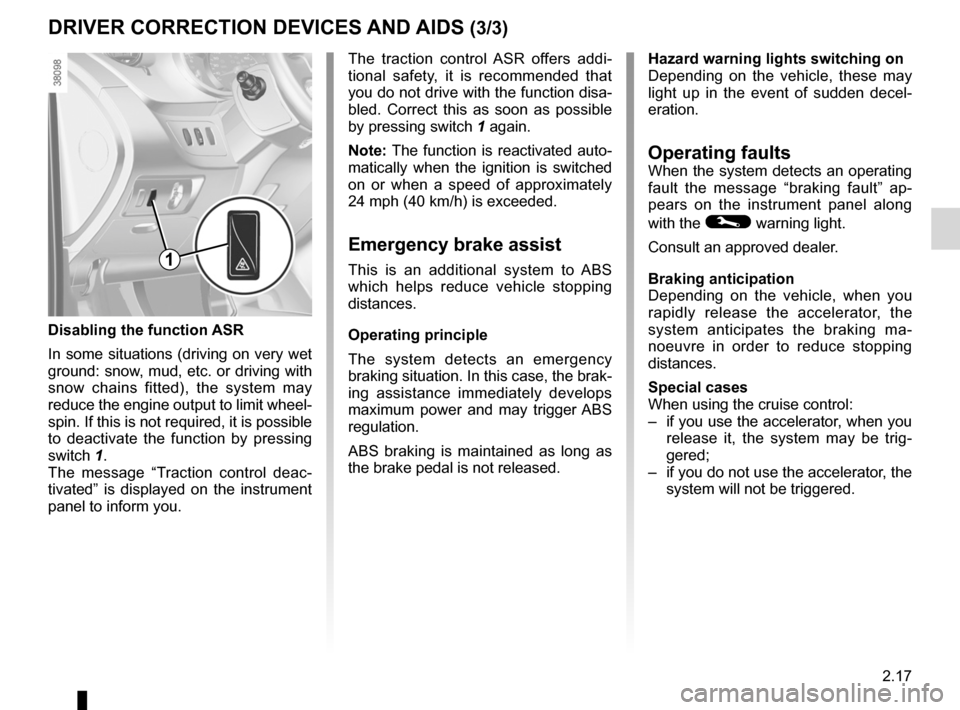
JauneNoirNoir texte
2.17
ENG_UD29758_3
Dispositifs de correction de conduite (X61 - F61 - K61 - Renault)
ENG_NU_813-11_FK61_Renault_2
Disabling the function ASR
In some situations (driving on very wet
ground: snow, mud, etc. or driving with
snow chains fitted), the system may
reduce the engine output to limit wheel -
spin. If this is not required, it is possible
to deactivate the function by pressing
switch 1.
The message “Traction control deac -
tivated” is displayed on the instrument
panel to inform you. The traction control ASR offers addi
-
tional safety, it is recommended that
you do not drive with the function disa-
bled. Correct this as soon as possible
by pressing switch 1 again.
Note: The function is reactivated auto-
matically when the ignition is switched
on or when a speed of approximately
24 mph (40 km/h) is exceeded.
Emergency brake assist
This is an additional system to ABS
which helps reduce vehicle stopping
distances.
Operating principle
The system detects an emergency
braking situation. In this case, the brak-
ing assistance immediately develops
maximum power and may trigger ABS
regulation.
ABS braking is maintained as long as
the brake pedal is not released.
DRIVER CORRECTION DEVICES AND AIDS (3/3)
Hazard warning lights switching on
Depending on the vehicle, these may
light up in the event of sudden decel -
eration.
Operating faultsWhen the system detects an operating
fault the message “braking fault” ap -
pears on the instrument panel along
with the
© warning light.
Consult an approved dealer.
braking anticipation
Depending on the vehicle, when you
rapidly release the accelerator, the
system anticipates the braking ma -
noeuvre in order to reduce stopping
distances.
Special cases
When using the cruise control:
– if you use the accelerator, when you
release it, the system may be trig -
gered;
– if you do not use the accelerator, the
system will not be triggered.
1